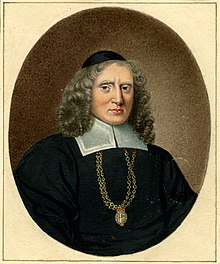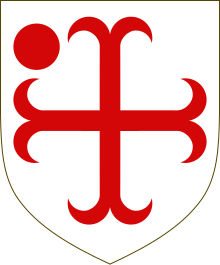William Dugdale

Sir William Dugdale (12 September 1605 – 10 February 1686) was an English
Life
This section relies largely or entirely on a single source. (January 2023) |
Dugdale was born at Shustoke, near Coleshill in Warwickshire, where his father, John Dugdale, was steward to the local landowner. As he was born, a swarm of bees flew into the garden, which some considered "a happy presage on the life of the babe".
He was educated at
In 1638, through the influence of his friends Dugdale was created a pursuivant of arms extraordinary by the name of Blanche Lyon, and, in 1639, he was promoted to the office of Rouge Croix Pursuivant of Arms in Ordinary. The accommodation in the College of Arms and the income from his post enabled him to pursue his research in London.
According to his later account, in 1641 Sir Christopher Hatton, foreseeing the English Civil War and dreading the ruin and spoliation of the Church, commissioned him to make exact drafts of all the monuments in Westminster Abbey and the principal churches in England.

In June 1642, he was summoned with the other heralds to attend the king at York. When the war broke out Charles deputed him to summon the castles of Banbury and Warwick to surrender.
He witnessed the
During his leisure at Oxford he collected material at the Bodleian Library and college libraries for his books. It was during these years that he met Elias Ashmole, who later became his son-in-law. Following the surrender of Oxford in 1646 Dugdale returned to Blyth Hall and compounded for his estates under the terms of the Oxford articles. Hatton, who had opposed the surrender, went into exile in France, where Dugdale visited him in 1648.
He recommenced his antiquarian researches, collaborating with Roger Dodsworth on the Monasticon Anglicanum, the first volume of which was published in 1655. In the following year he published his own Antiquities of Warwickshire, which was soon recognised as a model county history. In this work he was one of the first to consider the significance of stone tools, stating these were "weapons used by the Britons before the art of making arms of brass or iron was known".[1]
At the
In 1677 he was knighted and promoted to the office of Garter Principal King of Arms, which he held until his death. In his last years he wrote an account of his life at the request of Anthony Wood. He died "in his chair" at Blyth Hall in 1686, aged 80.
Works
- Monasticon Anglicanum (1655–1673);[2] As can be read on the title page, the original was written in Latin and the work linked to here is the version translated into English and abridged by James Wright. This version was published in 1693.[2]
- Antiquities of Warwickshire (1656)
- History of St Paul's Cathedral (1658)
- The History of Imbanking and Drayning (1662)[3]
- Origines Juridiciales (1666)
- Baronage of England (1675–1676)
- A Short View of the Late Troubles (1681)
- Ancient Usage of Bearing Arms (1682)
- Visitations of Derbyshire, Yorkshire, etc.[4]
He also edited Sir Henry Spelman's Glossarium Archaiologicum (1664) and Concilia (1664), adding his own extensions to the latter. His Life, written by himself up to 1678, with his diary and correspondence, and an index to his manuscript collections, was edited by William Hamper, and published in 1827.
Arms

|
|
Legacy
The Dugdale Society, a text publication society for Warwickshire, takes its name from William Dugdale.
See also
References
- ISBN 978-0-14-101813-3.
- ^ a b Dugdale, Sir William (1693). "Monasticon Anglicanum". or The History of the Ancient Abbies, and other Monasteries, Hospitals, Cathedral and Collegiate Churches, in England and Wales. With Divers French, Irish, and Scotch Monasteries Formerly relating to England (Translated from the Latin). London: Sam Keble and Hen Rhodes. Retrieved 3 January 2010. Full text at Internet Archives.
- ^ "The history of imbanking and drayning of divers fenns and marshes, both in forein parts and in this kingdom, and of the improvements thereby extracted from records, manuscripts, and other authentick testimonies / by William Dugdale". Quod.lib.umich.edu. Retrieved 29 September 2015.
- ^ "Dugdale's Visitation of Yorkshire, with additions". Exeter, W. Pollard & Co. 1899. Retrieved 29 September 2015.
- ^ Godfrey, Walter H; Wagner, Anthony (1963). "'Garter King of Arms', in Survey of London Monograph 16, College of Arms, Queen Victoria Street (London, 1963), pp. 38-74". british-history.ac.uk. Retrieved 1 November 2018.
- This article incorporates text from a publication now in the public domain: Chisholm, Hugh, ed. (1911). "Dugdale, Sir William". Encyclopædia Britannica (11th ed.). Cambridge University Press.
Sources
- Broadway, Jan (1999). William Dugdale and the Significance of County History in Early Stuart England. Dugdale Society Occasional Papers. Vol. 39. Stratford-upon-Avon: Dugdale Society.
- Broadway, Jan (2011). William Dugdale: a life of the Warwickshire historian and herald. Gloucester: Xmera. ISBN 9780956742803.
- ISBN 9781843834434.
- Hamper, William (1827). The Life, Diary, and Correspondence of Sir William Dugdale, Knight. London: Harding, Leppard, and Co.
- Maddison, Francis; Styles, Dorothy; Wood, Anthony (1953). Sir William Dugdale, 1605–1686: a list of his printed works and of his portraits, with notes on his life and the manuscript sources. Warwick: L. E. Stephens.
- Parry, Graham (2009) [2004]. "Dugdale, Sir William (1605–1686)". doi:10.1093/ref:odnb/8186. (Subscription or UK public library membershiprequired.)
- Scroggs, E. S. (1937). "Sir William Dugdale, 1605–86". Journal of the British Archaeological Association. 3rd ser. 2 (1): 1–16. .
